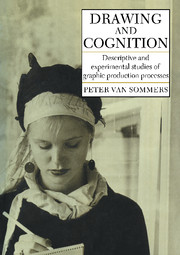Book contents
- Frontmatter
- Contents
- Preface
- 1 Basic executive constraints in drawing
- 2 Maintaining paper contact, anchoring, and planning
- 3 The reproduction of rectilinear figures
- 4 The production of curvilinear forms
- 5 The impact of meaning on executive strategies
- 6 Simple representational drawing
- 7 Difficult graphic tasks: A failure in perceptual analysis?
- 8 Stability and evolution in children's drawings
- 9 Innovations, primitives, contour, and space in children's drawings
- 10 Children's repeated drawings: How are innovations coded?
- 11 The pragmatics of everyday graphic production
- References
- Index
10 - Children's repeated drawings: How are innovations coded?
Published online by Cambridge University Press: 07 October 2011
- Frontmatter
- Contents
- Preface
- 1 Basic executive constraints in drawing
- 2 Maintaining paper contact, anchoring, and planning
- 3 The reproduction of rectilinear figures
- 4 The production of curvilinear forms
- 5 The impact of meaning on executive strategies
- 6 Simple representational drawing
- 7 Difficult graphic tasks: A failure in perceptual analysis?
- 8 Stability and evolution in children's drawings
- 9 Innovations, primitives, contour, and space in children's drawings
- 10 Children's repeated drawings: How are innovations coded?
- 11 The pragmatics of everyday graphic production
- References
- Index
Summary
Two illustrations in Eng's The Psychology of Drawing (1954) depict an assemblage of dolls drawn by a girl of 5.11 years. Most of the dolls wear cloaks, which Eng says have their origins in an error that became stylized into what she calls a “formula.” There are no details given of the construction process beyond the fact that in the initial drawing a basic triangular female figure was accidentally elaborated by two long sloping lines that were later “discovered” by the child to represent a cloak.
A close examination of the dolls drawn 3 and 10 days after the initial accidental creation of the cape motif reveals that the child used at least six different construction strategies to produce what are visually rather similar figures. Fig. 10.1 (a) and (b) show the relevant parts of the two drawings, and below in Fig. 10.1(c) are diagrams that expand the microstructure of the figures to show the various procedures.
Eng does not comment on this feature of the drawing, and when the variability first caught my attention, I assumed that if it was a real effect (as opposed to an error in reproduction, which seems unlikely), it surely represented a graphic oddity. Yet these illustrations now seem to crystallize very well what I wish to document more fully – the production of similar and distinctive graphic products by a variety of different means.
- Type
- Chapter
- Information
- Drawing and CognitionDescriptive and Experimental Studies of Graphic Production Processes, pp. 204 - 232Publisher: Cambridge University PressPrint publication year: 1984



